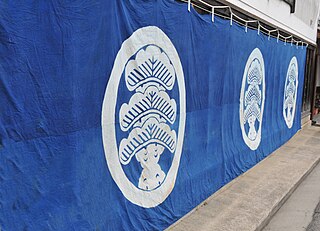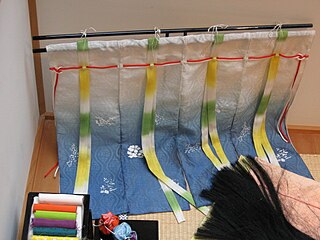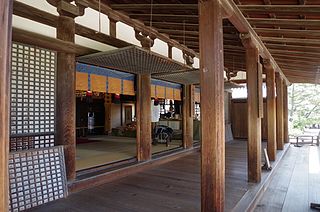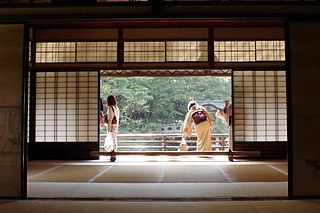 W
WByōbu (屏風) are Japanese folding screens made from several joined panels, bearing decorative painting and calligraphy, used to separate interiors and enclose private spaces, among other uses.
 W
WIn Japanese architecture, fusuma are vertical rectangular panels which can slide from side to side to redefine spaces within a room, or act as doors. They typically measure about 90 cm wide by 180 cm tall, the same size as a tatami mat, and are 2–3 cm (0.79–1.18 in) thick. The heights of fusuma have increased in recent years due to an increase in average height of the Japanese population, and a 190 cm height is now common. In older constructions, they are as small as 170 cm high. They consist of a lattice-like wooden understructure covered in cardboard and a layer of paper or cloth on both sides. They typically have a black lacquer border and a round finger catch.
 W
WJinmaku (陣幕) is a curtain used in setting up a military encampment commonly seen from the pre-modern era in Japan. The jinmaku were also historically known as a gunmaku (軍幕), or "military curtain".
 W
WA kichō (几帳) is a portable multi-paneled silk partition supported by a T-pole. It came into use in aristocratic households during and following the Heian period (794–1185) in Japan when it became a standard piece of furniture. Kichō are similar in appearance to a kabeshiro , but are mounted on a free-standing stand rather than a lintel beam. They are less similar to noren, which do not include streamers to tie them up, and are generally used in different social settings.
 W
WNoren (暖簾) are traditional Japanese fabric dividers hung between rooms, on walls, in doorways, or in windows. They usually have one or more vertical slits cut from the bottom to nearly the top of the fabric, allowing for easier passage or viewing. Noren are rectangular and come in many different materials, sizes, colours, and patterns.
 W
WShitomi (蔀), also called hajitomi (半蔀) are square-lattice shutters or doors found on older-style Japanese buildings. They are characteristic of the Shinden style, and the Heian Period (794-1185). They were used in aristocrats' palaces, and more rarely occur in temple buildings. They were replaced by sliding panels in the Shoin style.
 W
WA shōji is a door, window or room divider used in traditional Japanese architecture, consisting of translucent sheets on a lattice frame. Where light transmission is not needed, the similar but opaque fusuma is used. Shoji usually slide, but may occasionally be hung or hinged, especially in more rustic styles.
 W
WSudare are screens or blinds. They are also sometimes called misu (御簾/みす), particularly if they have a green fabric hem. Sudare are made of horizontal slats of decorative wood, bamboo, or other natural material woven together with simple string, colored yarn, or other decorative material to make nearly solid blinds. They can be either rolled or folded up out of the way. Yoshizu, non-hanging sudare, are made of vertical slats of common reed and used as screen.
 W
WA tsuitate (衝立) is a form of single-panel portable partition traditionally used in Japan since at least the 6th century. They may be made of wood, or a wood frame covered in paper or silk cloth. The panels are often illustrated, with paintings on both sides, sometimes by well-known artists. The wood frame may be lacquered, and pricier tsuitate may be very richly decorated, including use of precious metals.